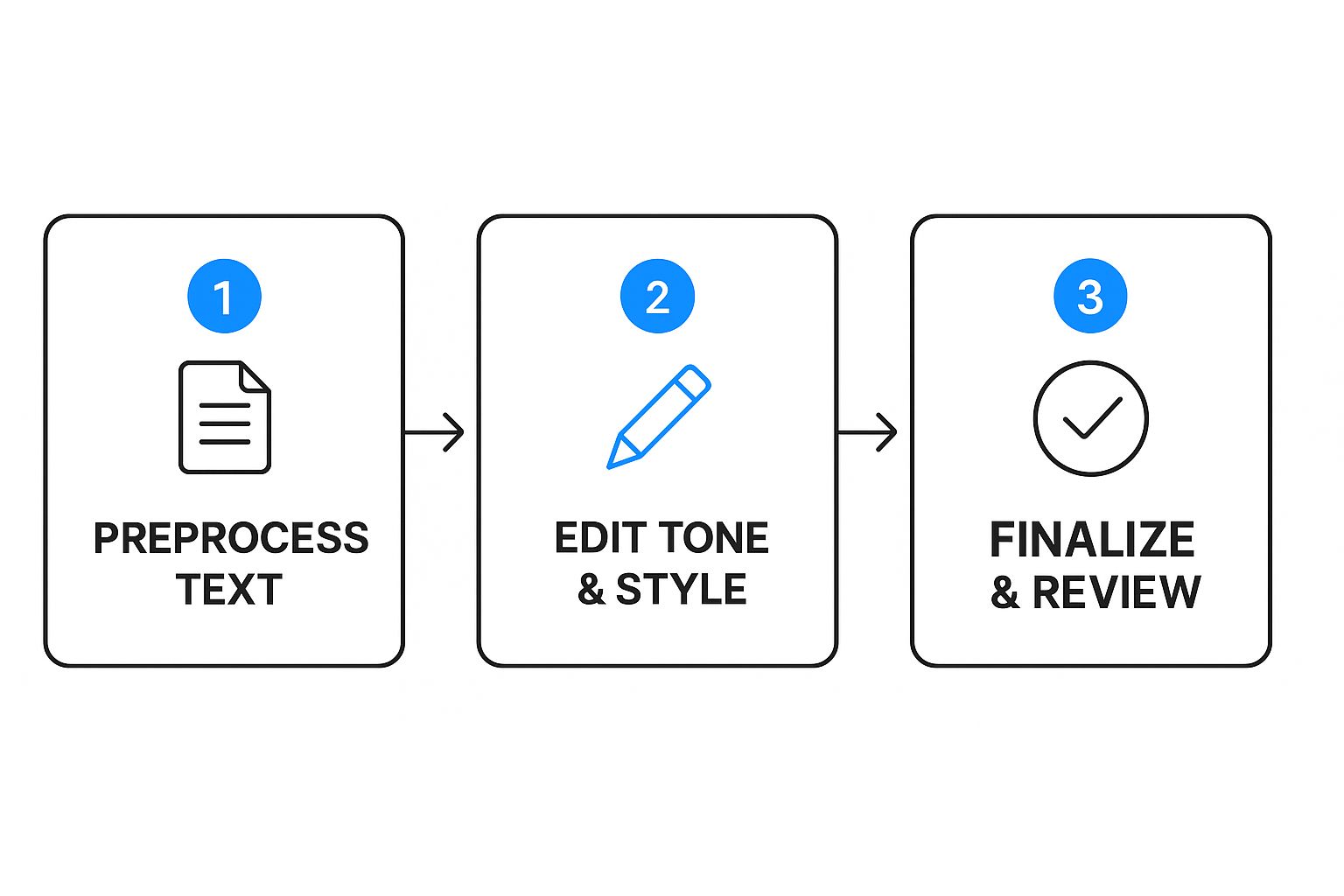How to Turn AI Text into Human Text: Proven Tips for Authentic Content

To truly turn AI text into something that reads like it was written by a person, you have to edit for three key things: personality, rhythm, and clarity. Think of the raw AI output as a solid, but uninspired, first draft. Your job is to step in and add the unique insights, conversational tone, and real-life experiences that make content memorable.
Why Raw AI Content Often Falls Flat

You can usually spot raw AI content from a mile away. It often feels a little too perfect, almost sterile, and lacks the distinct voice that makes writing connect. It’s like a perfectly constructed building with no furniture—functional, but cold and uninviting.
The goal isn’t to ditch AI altogether. It’s about taking its efficient output and breathing life into it, turning it into something that genuinely resonates with people. That whole process starts with knowing what to look for.
The Telltale Signs of AI Writing
AI models are trained on gigantic datasets, and just like people, they develop certain habits. These patterns are often what make the text feel “off” to a human reader.
You’ll start to notice a few common giveaways:
- Repetitive Sentence Structures: AI loves to fall back on the same sentence formats and lengths, which creates a monotonous, singsong rhythm.
- Overly Formal Tone: The content can sound like a textbook, using unnecessarily complex words when simpler ones would be more effective and engaging.
- No Personal Experience: Without real-world stories, opinions, or anecdotes, the text feels generic and hollow. It lacks authority.
This isn’t just about style; it’s about performance. Google keeps tweaking its algorithms to reward high-quality, human-first content. As resources on Google’s Helpful Content Update highlight, failing to add that human element can seriously tank your rankings.
The bottom line is this: Raw AI content is a powerful starting point, but the empathy, unique voice, and memorable stories come directly from you. That human touch is non-negotiable for building trust and creating content people actually want to share.
This quick comparison table highlights the key differences between raw AI output and polished human writing, helping you pinpoint exactly what to fix.
AI vs Human Writing Telltale Signs
| Characteristic | Common in AI Text | Hallmark of Human Text |
|---|---|---|
| Tone & Voice | Often formal, neutral, or overly enthusiastic. Lacks a consistent personality. | Consistent, authentic voice. Can be witty, empathetic, or authoritative. |
| Sentence Structure | Monotonous rhythm with similar sentence lengths and predictable patterns. | Varied sentence lengths—short and punchy mixed with longer, flowing ones. |
| Word Choice | Uses clichés, jargon, and unnecessarily complex vocabulary. | Uses precise, natural language, including idioms and colloquialisms. |
| Flow & Transitions | Can feel disjointed or use formulaic transitions like “In conclusion…” | Smooth, logical flow with natural transitions that guide the reader. |
| Perspective | Lacks personal anecdotes, opinions, or unique real-world examples. | Infused with personal stories, expert insights, and original thought. |
This table should make it clear why a hybrid approach is becoming the industry standard. Using AI for the first draft and bringing in a human for post-editing strikes the perfect balance between speed and quality.
In fact, studies show human translators outperform machines by an average of 18% in nuanced accuracy—a gap that gets even wider in fields like marketing, where cultural context is everything. The future isn’t AI or humans; it’s AI assisting humans.
Weaving Your Authentic Voice into the Mix

This is where the real work—and the real magic—begins. AI is fantastic at building a factual foundation, but it can’t share your unique experiences or offer a genuine point of view. Turning a generic draft into something that truly connects with a reader means infusing it with your authentic voice.
Forget the bland, cookie-cutter examples. The goal here is to add the parts of yourself that an algorithm simply can’t replicate. This is your chance to weave in personal anecdotes, insightful opinions, and real-world stories that make the content breathe.
Finding Your Brand’s Tone
Before you start editing, you need a clear picture of the voice you’re going for. Is your brand witty and a bit irreverent? Or is it more professional and deeply empathetic? A consistent tone is what builds a strong, recognizable connection with your audience.
Once you’ve nailed down your voice, you can start making specific, targeted edits to match it:
- Witty and Casual: Swap formal words like “utilize” for something simpler, like “use.” Toss in a few playful asides or even a well-placed joke to keep things light.
- Professional and Authoritative: Back up vague claims with hard data and specific numbers. Keep your language direct, clear, and confident.
- Empathetic and Supportive: Use words like “you” and “we” to build a sense of community. Address your reader’s pain points head-on and offer genuine, actionable solutions.
This isn’t just about swapping a few words; it’s about shaping the entire reader experience from start to finish.
Turning a Textbook into a Conversation
Let’s be honest: AI-generated text often reads like a dry, formal report. Your job is to mess it up a bit—in a good way. You want it to sound less like a lecture and more like a conversation between two people.
A simple trick I use is reading every sentence out loud. If it sounds clunky or unnatural, it gets rewritten. No exceptions.
Another great technique is to sprinkle in rhetorical questions. Asking something like, “But how does this actually play out in the real world?” immediately pulls the reader into the story. It makes them feel like an active participant, not just a passive observer.
The most powerful content doesn’t just inform; it connects. By sharing a bit of yourself through stories and a consistent tone, you create something that people remember long after they’ve clicked away.
Of course, manually reworking an entire article to get the tone just right can be a huge time sink. This is exactly where a specialized tool can help. For instance, Word Spinner is a leading choice for this, with advanced rewriting capabilities that humanize content for a natural tone. It also guarantees 100% plagiarism-free output that bypasses AI detection. For a deeper look at this process, check out our guide on how to humanize AI content.
This trend toward more human-sounding digital communication is growing. Technologies like voice cloning and AI speech translation are advancing so quickly that projections show by 2025, about 30% of multimedia projects could use this tech to keep emotional authenticity consistent across different languages. It’s another clear sign that the future of content is all about making digital interactions feel more human.
Crafting a Natural Rhythm and Flow

One of the dead giveaways of AI-generated content is its robotic, predictable rhythm. It tends to spit out sentences of similar length and structure, creating a monotonous cadence that will put any reader to sleep. Breaking this pattern is everything when it comes to making your writing dynamic and engaging.
To turn that AI output into something that sounds human, you have to get intentional about varying your sentence structure. Think about it like a song—you need quiet verses and loud, powerful choruses to keep the listener hooked. The same idea applies directly to your writing.
Varying Your Sentence Structure
Your first move should be mixing short, punchy sentences with longer, more descriptive ones. This simple trick creates a natural ebb and flow that keeps your reader’s eyes glued to the page.
Take this bland, AI-generated sentence for example:
“AI writing tools are beneficial for content creators because they save time, and they also improve efficiency in the workflow.”
Now, let’s chop it up for a better rhythm:
“AI writing tools help content creators. They save time. They make workflows more efficient.”
See the difference? That simple edit creates a much more direct and powerful impact. On the flip side, you can also combine a series of short, choppy sentences into a single, more elegant one to unpack a complex idea. The secret sauce is intentional variety.
Rhythm isn’t just about sounding good—it’s about controlling the reader’s pace. Short sentences create urgency and emphasis, while longer sentences allow for deeper explanation and a more relaxed feel.
Many of the best writing principles, especially those for creating a natural rhythm, can be borrowed from other creative fields. For a little inspiration on how structure and flow build impact, you can even explore essential songwriting tips and see how those concepts translate to your own work.
Using Transitions That Feel Natural
AI often leans on clunky, formulaic transition words. Phrases like “Furthermore,” “In addition,” and “Therefore” can make your writing feel stiff and academic. While they have their place, overusing them is a huge red flag that a machine was behind the wheel.
Your goal should be to create seamless transitions that guide the reader from one point to the next without being so obvious about it.
Here are a few ways to smooth things out:
- Ask a Question: Start a new paragraph with a question that the previous one naturally brings up.
- Use Echo Words: Repeat a key word or phrase from the end of one paragraph right at the start of the next. It’s a simple way to create a clear link.
- Imply the Connection: Sometimes, the best transition is no transition word at all. If the logic flows clearly from one paragraph to the next, just let it happen naturally.
For instance, instead of writing, “Additionally, you should check for grammar,” try something like, “Once the flow feels right, what’s next? Polishing your grammar.” This small shift makes the text feel less like a checklist and more like a handcrafted story—a critical step in truly making the words your own.
Hands-On Editing for a Human Touch
Once you’ve got the rhythm and voice feeling right, it’s time to roll up your sleeves for the final pass. This is where the real magic happens—the hands-on editing phase. We’re going way beyond a simple grammar check to hunt down those subtle, robotic habits that scream “AI-generated.”
Think of this as the final polish that separates amateur content from professional, high-quality work. It’s all about precision. You’re on a mission to eliminate filler words, redundant phrases, and the generic vocabulary that AI models love to use, making sure every single word earns its place.
Spotting and Slaying AI Habits
AI tools, for all their power, have some bad habits they can’t seem to shake. One of the biggest offenders is using fluffy phrases and filler words that add zero value. You’ll see things like “in order to” when just “to” works perfectly fine, or “it is important to note that” before making a point.
Cutting this stuff out instantly makes your writing tighter and more impactful. Here are a few common culprits to add to your hit list:
- Redundant Pairs: Get rid of phrases like “completely finished” or “final outcome.” They’re repetitive.
- Vague Qualifiers: Words like “very,” “really,” and “basically” often do more harm than good, weakening your statements.
- Overly Formal Language: Swap out clunky words like “utilize” for “use” or “commence” for “start.” Keep it simple and direct.
If you want to go deeper on this, our guide on how to edit AI-generated content for a human touch is packed with more detailed checklists for spotting these sneaky errors.
The Read-Aloud Review
This is my secret weapon, and it costs nothing. Reading your text out loud is the single best way to catch awkward phrasing that your eyes might just skim over. It forces you to slow down and actually hear the content the way your audience will.
You’ll immediately pick up on clunky sentences, weird word choices, and any spots where the flow just feels off. If you find yourself stumbling over a sentence as you read it, that’s a dead giveaway it needs a rewrite. It’s the ultimate quality control check before you hit publish.
A common mistake is trusting the AI’s output without verification. Always fact-check every statistic, claim, and date. AI can “hallucinate” or pull from outdated sources, and a single inaccuracy can destroy your credibility.
This kind of human oversight isn’t just a nice-to-have; it’s essential. Even a tiny mistake can have huge consequences. For example, a misplaced comma in a sales contract once led to a $70 million loss for a defense firm. This is exactly why human vigilance is so critical, especially when businesses use AI for speed but need people to ensure the final output is accurate and culturally on-point. You can find more insights on translation quality and its importance over at Lokalise.com.
Using the Right Tools to Work Smarter
Let’s be real: manually editing every single sentence of an AI draft is a slow, painful grind. Instead of fighting against the machine, the smart move is to use it to speed up your workflow. The right tools can help you work faster and more efficiently, freeing you up to focus on the creative touches that actually matter.
The goal isn’t just to find a tool that swaps out a few words. You need something that helps you find better phrasing, adjust the tone on the fly, and do the heavy lifting of restructuring those clunky, robotic sentences. This approach lets you get straight to adding your own unique insights and personal stories.
A Smarter Workflow for Humanizing Text
Instead of seeing this as one giant editing task, break it down. A simple, tool-assisted workflow will keep you from getting bogged down in minor edits and focus your energy where it has the most impact.
This visual breaks down a simple three-step process for using tools the right way.

As you can see, the key is to run the text through a powerful tool before you dive into the final, nuanced edits yourself.
Start by generating your first draft with your go-to AI model. Then, run that raw output through a specialized rewriting platform to handle the awkward syntax and improve the overall flow. After that, your final editing pass becomes so much easier, letting you focus purely on adding that personal touch.
To help streamline this process, you can explore a range of AI powered productivity tools that assist with all stages of content creation, from brainstorming to final polishing.
Choosing a True AI Humanizer
Not all rewriting tools are created equal. A lot of basic paraphrasers just shuffle words around, which can sometimes make the text sound even more unnatural. A true AI humanizer goes much deeper—it refines syntax, adjusts tone, and varies sentence complexity to produce something that genuinely sounds like a person wrote it.
An advanced platform like Word Spinner is designed specifically to humanize text for a natural tone and help it fly under the radar of AI detection. Its powerful rewriting engine gives you a huge head start on your edits.

This screenshot shows how a dedicated humanizer gives you options to adjust the tone and complexity, giving you real control over the final output.
Instead of just getting one rewritten version, you get multiple suggestions to use for inspiration or adopt directly. It’s like having a creative partner that helps you quickly overcome writer’s block and find the perfect phrasing. You can learn more by checking out some of the best AI humanizer options out there and seeing how they fit into different workflows.
By letting a specialized tool handle 80% of the structural rewrite, you can spend your time on the final 20%—the part that involves adding your unique voice, expertise, and stories. This is how you scale high-quality content without sacrificing authenticity.
Got Questions About Humanizing AI Text?
Once you start getting your hands dirty with AI-generated drafts, you’ll probably run into the same questions everyone else does. Answering these early on is key to building a solid workflow and avoiding common mistakes. Let’s tackle a few of the big ones.
The first question I always hear is about SEO. Can using AI content actually get you penalized? The honest answer: it can, but only if you’re lazy about it. Search engines are getting incredibly good at spotting low-effort, robotic content that doesn’t offer real value.
If you just copy and paste what an AI gives you, don’t expect to rank. But if you treat that AI draft as a starting point—something to be molded, fact-checked, and injected with your unique expertise—then it becomes a powerful SEO tool. It’s all about the quality of the final piece.
Paraphraser vs. AI Humanizer
Another common point of confusion is the difference between a paraphraser and a true AI humanizer. They sound similar, but they’re built for completely different jobs.
A basic paraphrasing tool just swaps out words and shuffles sentence structures. Its main goal is to avoid duplicate content flags. That’s it.
An AI humanizer goes much deeper. It looks at the rhythm, tone, and flow of the text to make it sound like a real person wrote it. A good humanizer smooths out the awkward phrasing and predictability that screams “AI.” We dive deeper into this in our guide on how to humanize AI texts.
The core difference is the goal. A paraphraser changes the words. A humanizer changes the feel, getting rid of the robotic fingerprints to create something that actually connects with a reader.
How Long Does This Really Take?
Finally, there’s the big question of time. How long does it actually take to humanize a 1,000-word article? Well, that depends.
If you start with a strong AI draft on a topic you know inside and out, a skilled editor might only need 30-60 minutes. They’ll spend that time adding personal anecdotes, sharpening the tone, and double-checking the facts.
But if the initial draft is clunky or requires heavy restructuring, you could be looking at a much longer process. This is where the right tools make a huge difference, doing the initial heavy lifting so you can focus on adding that crucial human touch.